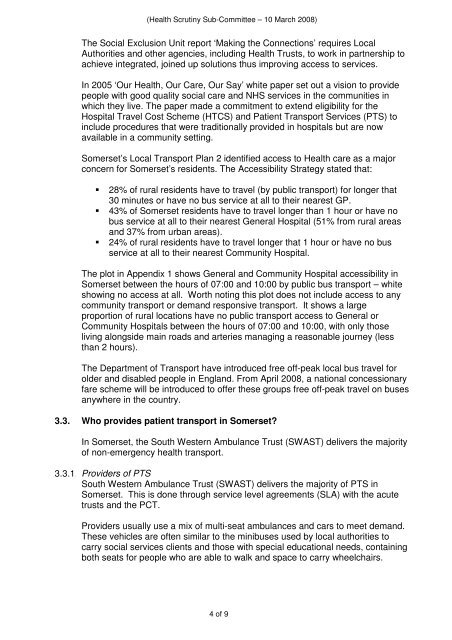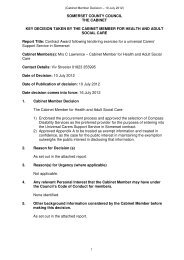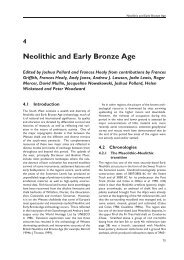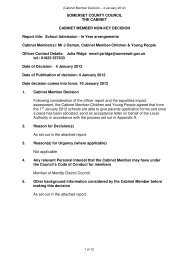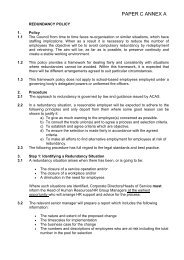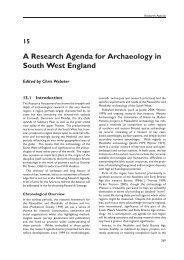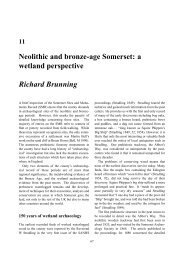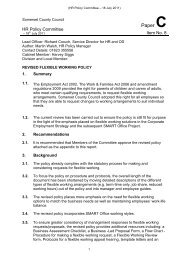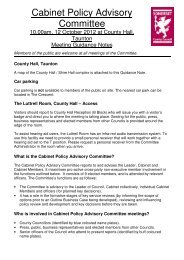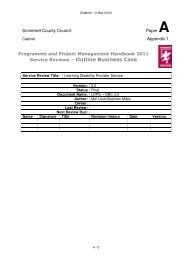Non-Emergency Transport for Health Patients in Somerset
Non-Emergency Transport for Health Patients in Somerset
Non-Emergency Transport for Health Patients in Somerset
- No tags were found...
You also want an ePaper? Increase the reach of your titles
YUMPU automatically turns print PDFs into web optimized ePapers that Google loves.
(<strong>Health</strong> Scrut<strong>in</strong>y Sub-Committee – 10 March 2008)The Social Exclusion Unit report ‘Mak<strong>in</strong>g the Connections’ requires LocalAuthorities and other agencies, <strong>in</strong>clud<strong>in</strong>g <strong>Health</strong> Trusts, to work <strong>in</strong> partnership toachieve <strong>in</strong>tegrated, jo<strong>in</strong>ed up solutions thus improv<strong>in</strong>g access to services.In 2005 ‘Our <strong>Health</strong>, Our Care, Our Say’ white paper set out a vision to providepeople with good quality social care and NHS services <strong>in</strong> the communities <strong>in</strong>which they live. The paper made a commitment to extend eligibility <strong>for</strong> theHospital Travel Cost Scheme (HTCS) and Patient <strong>Transport</strong> Services (PTS) to<strong>in</strong>clude procedures that were traditionally provided <strong>in</strong> hospitals but are nowavailable <strong>in</strong> a community sett<strong>in</strong>g.<strong>Somerset</strong>’s Local <strong>Transport</strong> Plan 2 identified access to <strong>Health</strong> care as a majorconcern <strong>for</strong> <strong>Somerset</strong>’s residents. The Accessibility Strategy stated that:28% of rural residents have to travel (by public transport) <strong>for</strong> longer that30 m<strong>in</strong>utes or have no bus service at all to their nearest GP.43% of <strong>Somerset</strong> residents have to travel longer than 1 hour or have nobus service at all to their nearest General Hospital (51% from rural areasand 37% from urban areas).24% of rural residents have to travel longer that 1 hour or have no busservice at all to their nearest Community Hospital.The plot <strong>in</strong> Appendix 1 shows General and Community Hospital accessibility <strong>in</strong><strong>Somerset</strong> between the hours of 07:00 and 10:00 by public bus transport – whiteshow<strong>in</strong>g no access at all. Worth not<strong>in</strong>g this plot does not <strong>in</strong>clude access to anycommunity transport or demand responsive transport. It shows a largeproportion of rural locations have no public transport access to General orCommunity Hospitals between the hours of 07:00 and 10:00, with only thoseliv<strong>in</strong>g alongside ma<strong>in</strong> roads and arteries manag<strong>in</strong>g a reasonable journey (lessthan 2 hours).The Department of <strong>Transport</strong> have <strong>in</strong>troduced free off-peak local bus travel <strong>for</strong>older and disabled people <strong>in</strong> England. From April 2008, a national concessionaryfare scheme will be <strong>in</strong>troduced to offer these groups free off-peak travel on busesanywhere <strong>in</strong> the country.3.3. Who provides patient transport <strong>in</strong> <strong>Somerset</strong>?In <strong>Somerset</strong>, the South Western Ambulance Trust (SWAST) delivers the majorityof non-emergency health transport.3.3.1. Providers of PTSSouth Western Ambulance Trust (SWAST) delivers the majority of PTS <strong>in</strong><strong>Somerset</strong>. This is done through service level agreements (SLA) with the acutetrusts and the PCT.Providers usually use a mix of multi-seat ambulances and cars to meet demand.These vehicles are often similar to the m<strong>in</strong>ibuses used by local authorities tocarry social services clients and those with special educational needs, conta<strong>in</strong><strong>in</strong>gboth seats <strong>for</strong> people who are able to walk and space to carry wheelchairs.4 of 9


